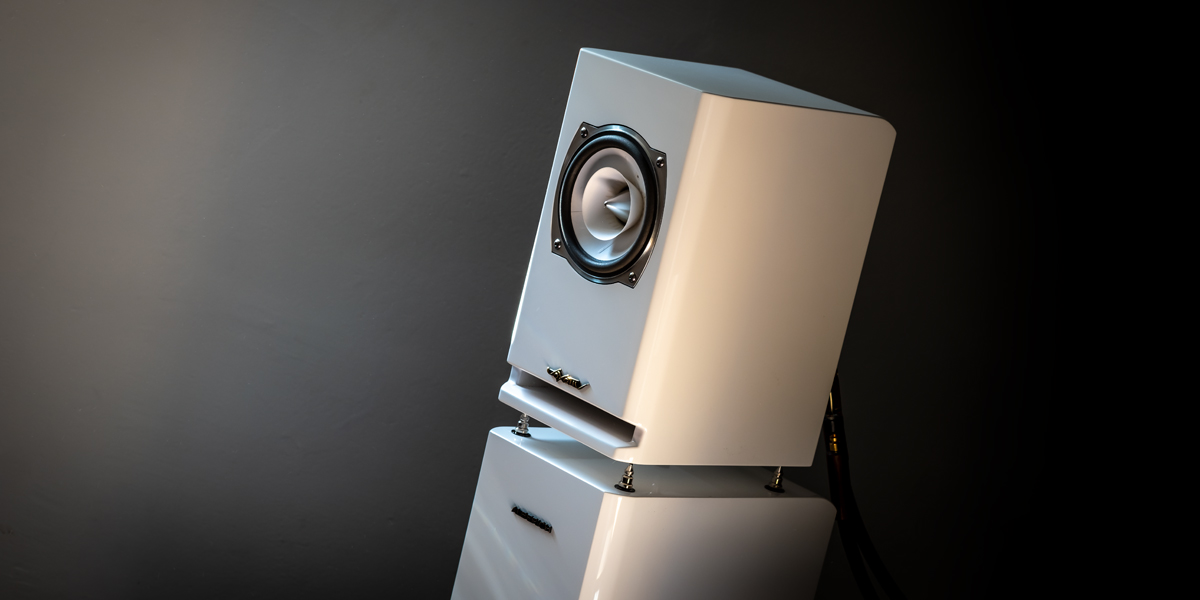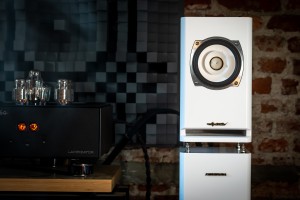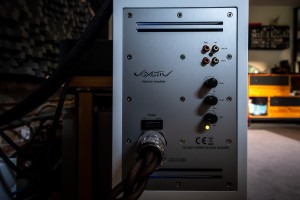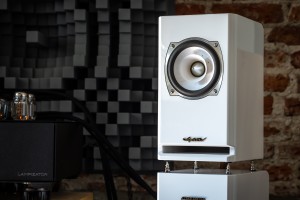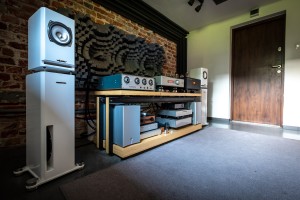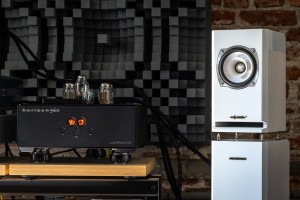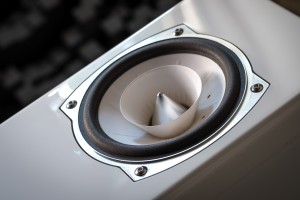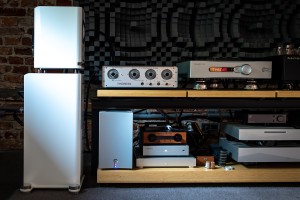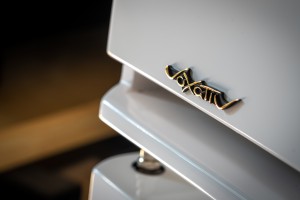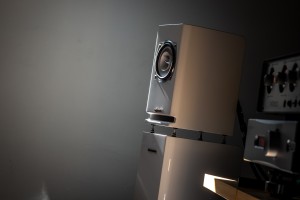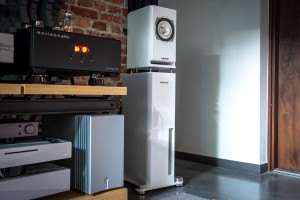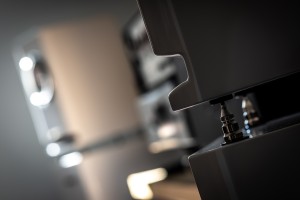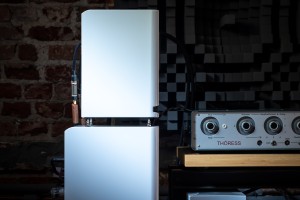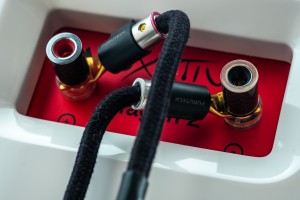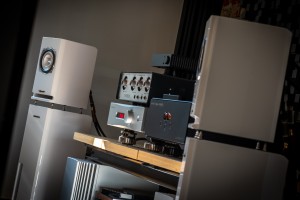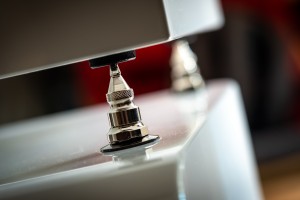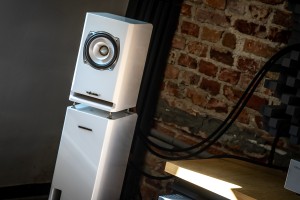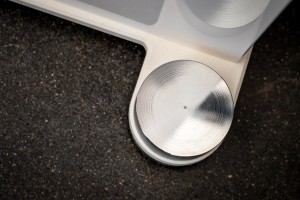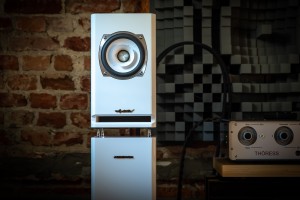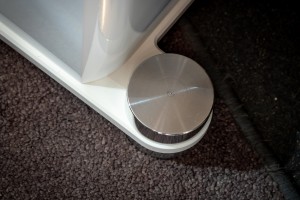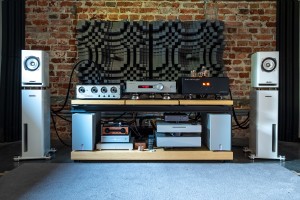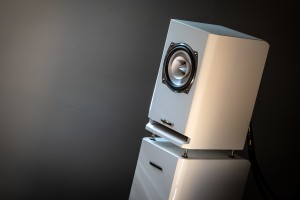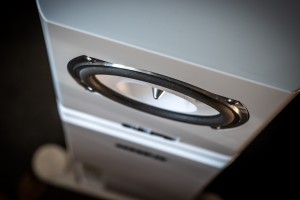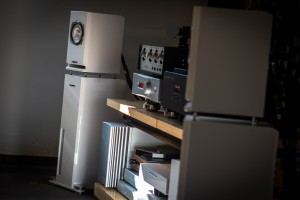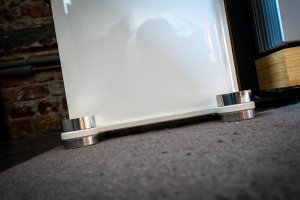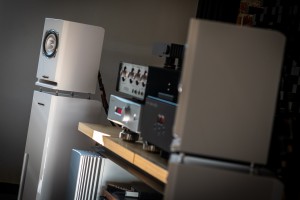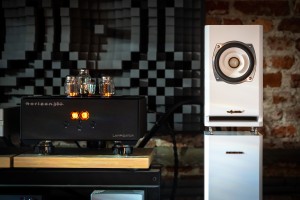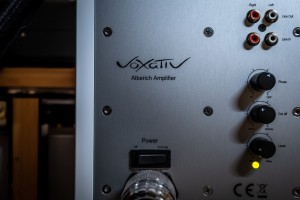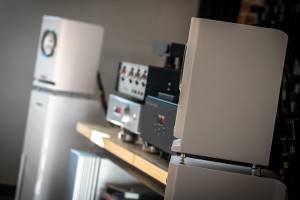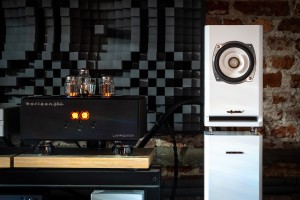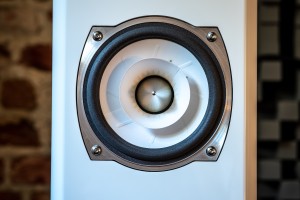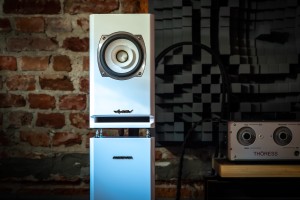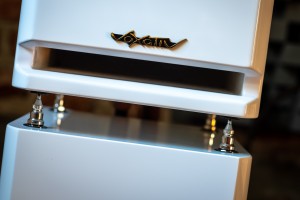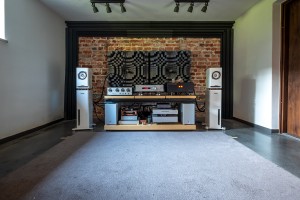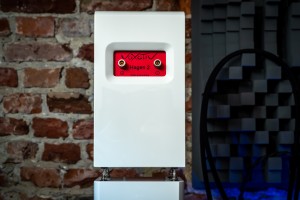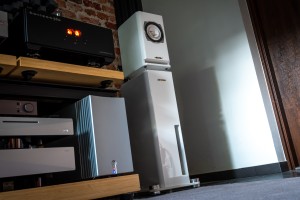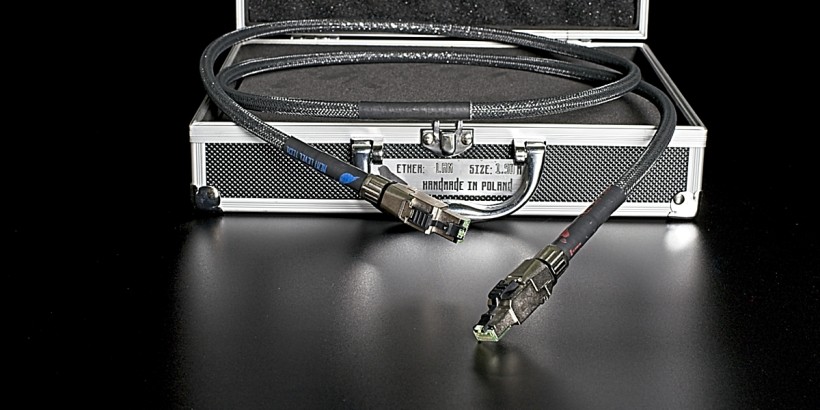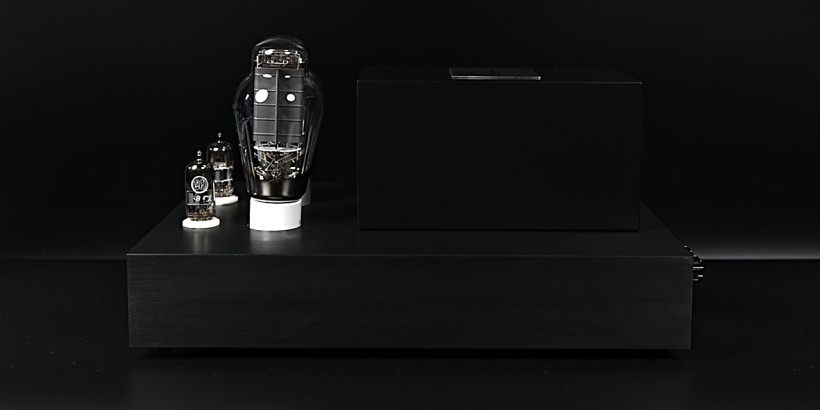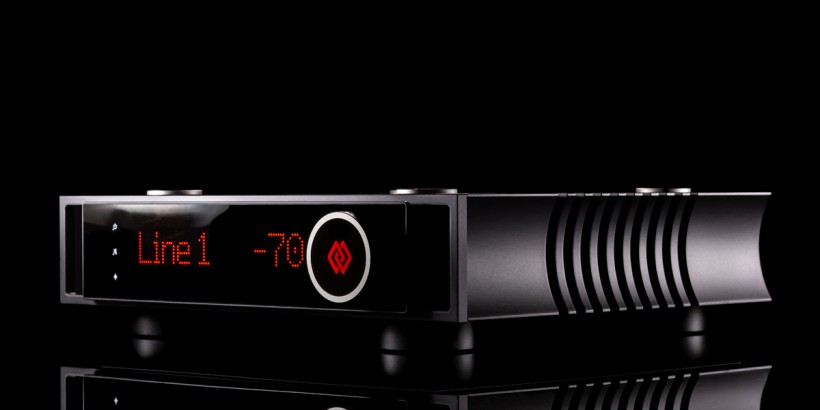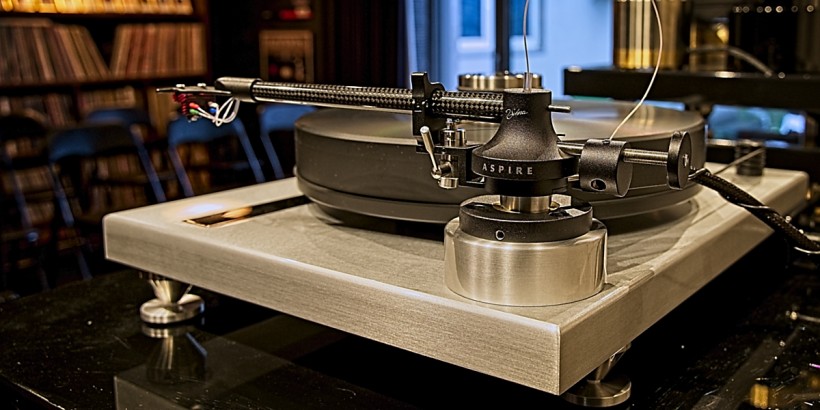In August 2024, the German company Voxativ released their Hagen2 monitor. One spring later it had flourished into a full-sized two-box Voxativ Alberich2 system. That’s our subject this time around. Enjoy!
Vox rationis
Expectations and reality don’t always match. Recently I experienced this firsthand while working on my Avantgarde Acoustic Duo SD review. Prior to this assignment, my exposure to proper horn speakers narrowed down only to those I was able to see and hear during many Munich and Warsaw gigs. As interesting and intriguing as horns are, during these shows their kind occupied spaces far larger than the 21m2 room at my disposal. Knowing this, for many years I was convinced that by default it said nay to any such arrivals. Robert, who is the local Avantgarde Acoustic distributor, simply begged to differ. To him, cramming two Duo SD coffins with massive waveguides into my compact listening cave was good fun and splendid idea in general. While he wouldn’t mind me picking something else from his very much upscale roster packed with Kondo, Estelon, Siltech and the likes, cold reality check came quickly. I know horns only from audio events. Robert’s been selling them for 20+ years and very effectively at that. Hello? If he considered Duo SD a good fit at my place, well, pretending to be smarter on the matter he knew well and I didn’t was pointless and rather rude. Trust must, resistance was futile. We moved forward. The 200kg cargo implied backbreaking logistics. Robert’s team handled that spot on, too. What followed outgrew my at best modest expectations by a proverbial country mile.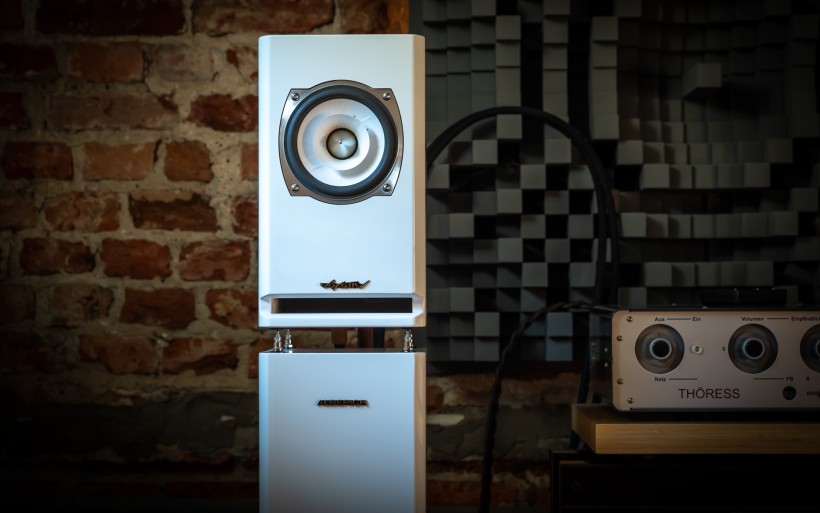 Until recently, large horns struck me as intimidating to say the least and tailored only for die-hard aficionados of their breed. Duo SD very quickly beat that opinion to a bloody pulp. Along the way it also squashed several not exactly favorable stereotypes associated with such speakers. This semi-active and optionally fully active effort was extremely approachable, versatile and ambitious. It boasted high-tiered audiophile flair all across the board. It also winked at casual listeners with money to spend, who fancy the idea of having at their living rooms a performance-wise highly competent visually modern horn speaker, albeit fronted by just one compact AiO device instead of a rack busy with specialist hardware. Nicely dressed, easy to set up and friendly, Duo SD catered to broad audience without a miss. In a way, it also defied its own very much non-mainstream pedigree. At the end of our time together, I saw it as the perfectly domesticated and executed horn design that also climbed to the top spot in my performance roster. I truly hadn’t seen that one coming. Duo SD didn’t get our red badge only because this was the first proper horn that I sampled. It accomplished something else instead. It opened my eyes and ears to one subject that is very much relevant to today’s story.
Until recently, large horns struck me as intimidating to say the least and tailored only for die-hard aficionados of their breed. Duo SD very quickly beat that opinion to a bloody pulp. Along the way it also squashed several not exactly favorable stereotypes associated with such speakers. This semi-active and optionally fully active effort was extremely approachable, versatile and ambitious. It boasted high-tiered audiophile flair all across the board. It also winked at casual listeners with money to spend, who fancy the idea of having at their living rooms a performance-wise highly competent visually modern horn speaker, albeit fronted by just one compact AiO device instead of a rack busy with specialist hardware. Nicely dressed, easy to set up and friendly, Duo SD catered to broad audience without a miss. In a way, it also defied its own very much non-mainstream pedigree. At the end of our time together, I saw it as the perfectly domesticated and executed horn design that also climbed to the top spot in my performance roster. I truly hadn’t seen that one coming. Duo SD didn’t get our red badge only because this was the first proper horn that I sampled. It accomplished something else instead. It opened my eyes and ears to one subject that is very much relevant to today’s story.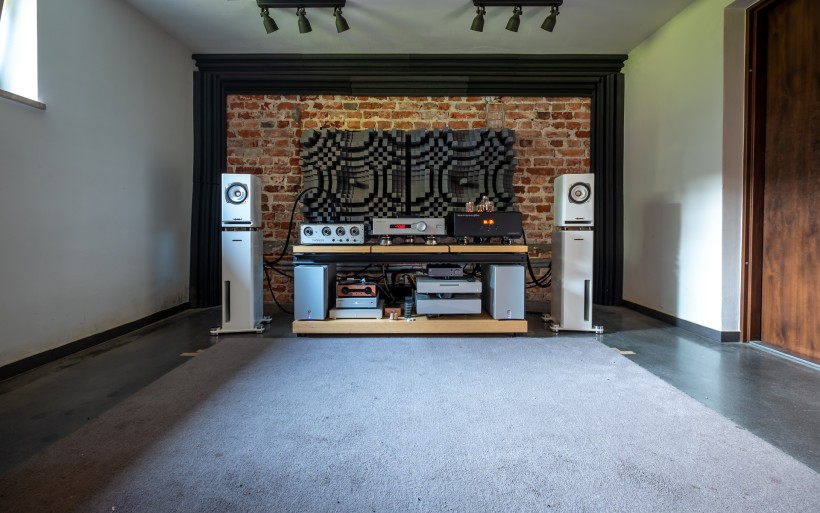 Avantgarde Acoustic Duo SD’s brilliant sonics were largely the byproduct of its actively powered, sealed and configurable subs. Once their tailoring to my room via handy software was done and dusted, just one 12″ woofer on a 500W class-D amp per channel allowed Duo SD to dig into the infrasonic realm and produce wickedly powerful, extremely punchy, effortless and very clean output even with the dynamically fiercest most bass-intense fare on the menu. On that particular score, these were most likely the best lows I’ve heard in my digs. As much as I enjoy passive speakers, the active/passive division of labor between each Duo SD’s woofer and its two horn-loaded neighbors was the common-sense designer choice that largely unlocked such superb results. The takeaway was painfully obvious. If speakers larger than Duo SD weren’t allowed, then active means seemed necessary to keep up with these horny floorstanders on tasks downstairs. Their passive drivers also welcomed low-power amps I had nearby, which atop superb bass made a world of difference at my place. I also learned something new about myself in the process. Horns stole half of my heart. Active bass took the other half.
Avantgarde Acoustic Duo SD’s brilliant sonics were largely the byproduct of its actively powered, sealed and configurable subs. Once their tailoring to my room via handy software was done and dusted, just one 12″ woofer on a 500W class-D amp per channel allowed Duo SD to dig into the infrasonic realm and produce wickedly powerful, extremely punchy, effortless and very clean output even with the dynamically fiercest most bass-intense fare on the menu. On that particular score, these were most likely the best lows I’ve heard in my digs. As much as I enjoy passive speakers, the active/passive division of labor between each Duo SD’s woofer and its two horn-loaded neighbors was the common-sense designer choice that largely unlocked such superb results. The takeaway was painfully obvious. If speakers larger than Duo SD weren’t allowed, then active means seemed necessary to keep up with these horny floorstanders on tasks downstairs. Their passive drivers also welcomed low-power amps I had nearby, which atop superb bass made a world of difference at my place. I also learned something new about myself in the process. Horns stole half of my heart. Active bass took the other half.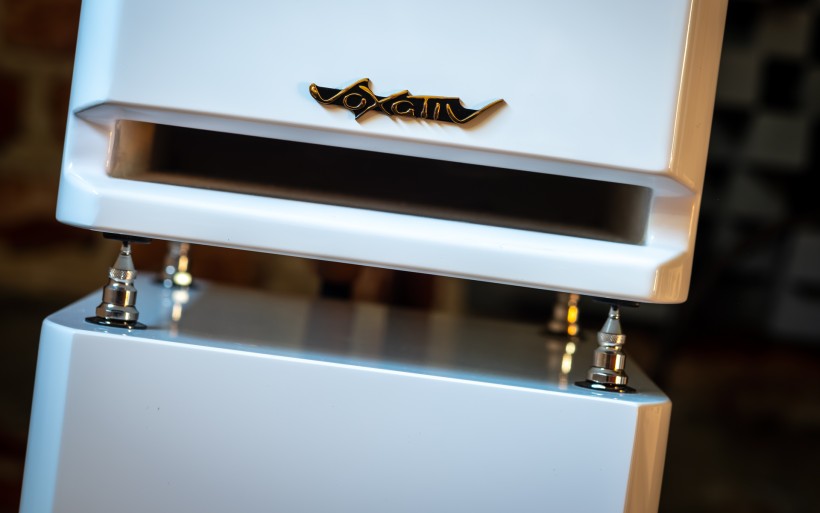 I didn’t expect Avantgarde Acoustic Duo SD to be the kind of monster that it turned out to be. Prior to its arrival I simply haven’t experienced anything quite like it. Today’s Voxativ Alberich2 however belongs to the rare full-range club that I’m very much accustomed to. Over the years I’ve guested a dozen its members. RDacoustic Evolution, Voxativ Zeth, Camerton Binom-1 and Cube Audio’s Magus, Nenuphar and Nenuphar Mini were all purist passives infused with a single unfiltered full-ranger per channel. The one used in Zu Audio DWX Supreme was assisted by a conventional tweeter. Enviée widebanders in sound|kaos Vox 3afw monitors were open on the bottom yet saw a 2nd-order slope on top and enjoyed support from Raal ribbons and side-firing woofers. Sven Boenicke’s own 6” drivers with wooden cones used i.e. in his W11 SE+ floorstanders were open on top, had a 1st-order low pass and also help from other cones. PureAudoProject Trio 10 was an open-baffle speaker with unfiltered Voxativ AF-1.5 driver and filtered woofers in it. Rethm Aarka and Maarga were the only two semi-actives with sealed bass and their makers’ own x-overless full-range transducers. This list only shows that the ways of implementing such drivers are many. While team Voxativ are familiar with all these methods, they’ve have been pursuing semi-active and purely passive single-driver protocols only.
I didn’t expect Avantgarde Acoustic Duo SD to be the kind of monster that it turned out to be. Prior to its arrival I simply haven’t experienced anything quite like it. Today’s Voxativ Alberich2 however belongs to the rare full-range club that I’m very much accustomed to. Over the years I’ve guested a dozen its members. RDacoustic Evolution, Voxativ Zeth, Camerton Binom-1 and Cube Audio’s Magus, Nenuphar and Nenuphar Mini were all purist passives infused with a single unfiltered full-ranger per channel. The one used in Zu Audio DWX Supreme was assisted by a conventional tweeter. Enviée widebanders in sound|kaos Vox 3afw monitors were open on the bottom yet saw a 2nd-order slope on top and enjoyed support from Raal ribbons and side-firing woofers. Sven Boenicke’s own 6” drivers with wooden cones used i.e. in his W11 SE+ floorstanders were open on top, had a 1st-order low pass and also help from other cones. PureAudoProject Trio 10 was an open-baffle speaker with unfiltered Voxativ AF-1.5 driver and filtered woofers in it. Rethm Aarka and Maarga were the only two semi-actives with sealed bass and their makers’ own x-overless full-range transducers. This list only shows that the ways of implementing such drivers are many. While team Voxativ are familiar with all these methods, they’ve have been pursuing semi-active and purely passive single-driver protocols only.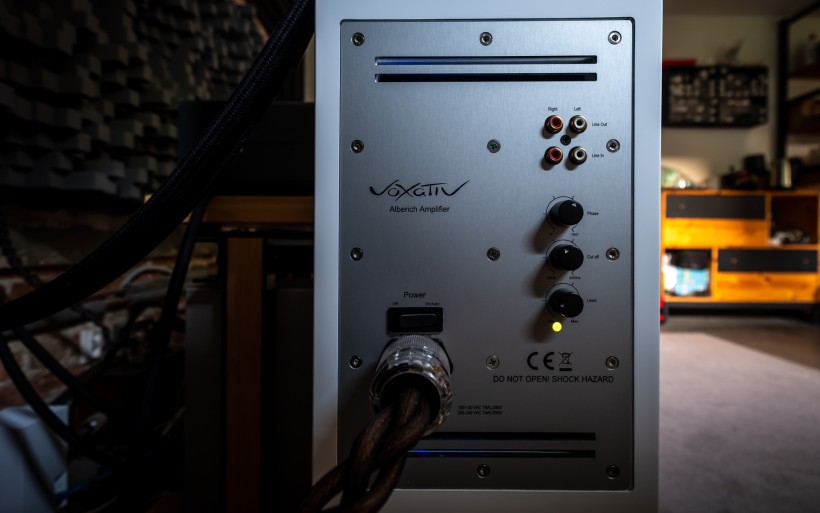 Founded by Marie Adler in Germany’s city of Berlin in the 90s, the specialist company Voxativ is known in the industry for boutique in-house made full-range transducers and speakers with them on board. This audio house is also particularly known for making a point how much just one sophisticated rear horn-loaded high-efficiency driver of wide bandwidth can achieve inside a sufficiently voluminous enclosure. An awful lot is about correct. The most affordable such a speaker in this portfolio – Hagen2 – sells for €7’900/pr, goes to 50Hz, is 95dB sensitive and styled like a compact monitor. The most expensive proposition – Ampeggio Due – boasts 110dB efficiency and 25Hz reach. It also shows 80kg on the scale, measures 120 x 140 x 19cm (W x H x D) and is priced at €100’000/pr. In both cases we essentially pay for two vented enclosures and as many drivers wired directly to their speaker posts. That’s it. Passive Voxativ models Andagio, Ampeggio, Zeth, Hagen Tower and Pi follow the same elegantly simple MO. Folks unfamiliar with their breed may consider them insane expenses given the parts involved. Should we think that the same coin easily buys us more stuff elsewhere, designing a driver fit for going solo is hard. Here’s another kicker. To work as intended and make sound unlike any other speaker out there, the passive Voxativ branch wants nothing else other than a driver with a large rear horn. Anything above that is in fact counter-productive excess. Most importantly, such designs operate the way they do because they eschew crossovers and are finessed single point-source propagators of high efficiency and unique qualities where it matters. They’re particularly brilliant on vocal and instrumental jobs, spatially mental and extremely gifted on quickness, immediacy, articulation, precision, directness and responsiveness. With well-matched and quite frankly mandatory companion amps, they’re also ace on tone provision, fruitiness, viscosity, persuasiveness and overall suchness. Over the years I’ve learned that the vast majority of conventional multi-ways can’t compete with crossoverless full-range speakers on these counts, let alone outclassing them. This is in fact just the driver type that I cherish the most as a reviewer and enthusiast.
Founded by Marie Adler in Germany’s city of Berlin in the 90s, the specialist company Voxativ is known in the industry for boutique in-house made full-range transducers and speakers with them on board. This audio house is also particularly known for making a point how much just one sophisticated rear horn-loaded high-efficiency driver of wide bandwidth can achieve inside a sufficiently voluminous enclosure. An awful lot is about correct. The most affordable such a speaker in this portfolio – Hagen2 – sells for €7’900/pr, goes to 50Hz, is 95dB sensitive and styled like a compact monitor. The most expensive proposition – Ampeggio Due – boasts 110dB efficiency and 25Hz reach. It also shows 80kg on the scale, measures 120 x 140 x 19cm (W x H x D) and is priced at €100’000/pr. In both cases we essentially pay for two vented enclosures and as many drivers wired directly to their speaker posts. That’s it. Passive Voxativ models Andagio, Ampeggio, Zeth, Hagen Tower and Pi follow the same elegantly simple MO. Folks unfamiliar with their breed may consider them insane expenses given the parts involved. Should we think that the same coin easily buys us more stuff elsewhere, designing a driver fit for going solo is hard. Here’s another kicker. To work as intended and make sound unlike any other speaker out there, the passive Voxativ branch wants nothing else other than a driver with a large rear horn. Anything above that is in fact counter-productive excess. Most importantly, such designs operate the way they do because they eschew crossovers and are finessed single point-source propagators of high efficiency and unique qualities where it matters. They’re particularly brilliant on vocal and instrumental jobs, spatially mental and extremely gifted on quickness, immediacy, articulation, precision, directness and responsiveness. With well-matched and quite frankly mandatory companion amps, they’re also ace on tone provision, fruitiness, viscosity, persuasiveness and overall suchness. Over the years I’ve learned that the vast majority of conventional multi-ways can’t compete with crossoverless full-range speakers on these counts, let alone outclassing them. This is in fact just the driver type that I cherish the most as a reviewer and enthusiast.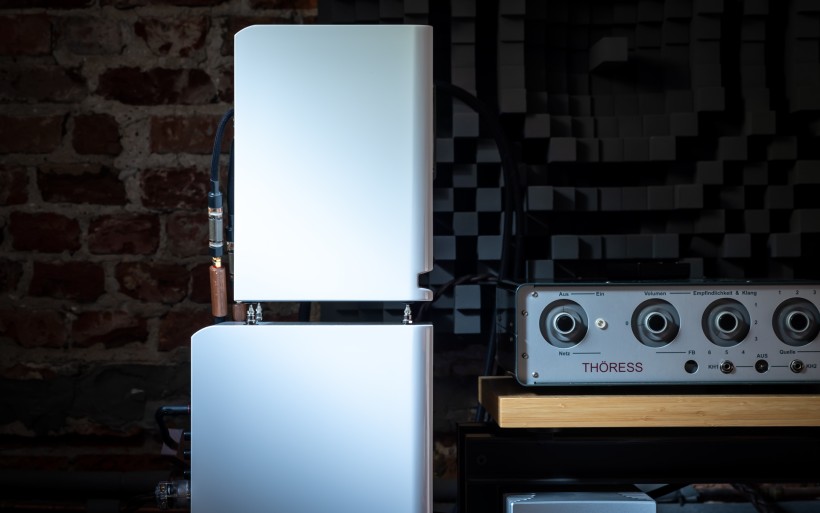 Passive Voxativ speakers are for those well-aware consumers who think that, in this hobby at least, less truly is more if executed right and ingredient quality is above quantity. To many of them, regular two- or three-ways on beefy amps were just a pit stop towards low-power tube SET magic, high efficiency, simplicity and resulting sound. I fully understand the appeal of this route and am not surprised that some veterans consider it to be their end game. Feeling 25Hz from just a single 7,5″ driver inside a large box connected to a flea-power amp is a very cool sensation and helluva party trick to boot. However, should we want to tap into these room-shaking frequencies atop all the other good stuff their kosher exciters inherently embed, i.e. Voxativ Ampeggio Due bluntly lets us know how large the internal horn loading and consequently enclosure size have to be. Not small. Ditto wallet depth. Therein lies the rub. Not many shoppers can pursue extremist efforts such as this one. Not many understand what it is to begin with. Not many connect its sound with the high-tiered designer simplicity that it proudly represents. To fully appreciate this unorthodox speaker type, you really have to be in the know. Team Voxativ are perfectly aware of this, too. This is why a fair share of their lineup is busy with more compact semi-active designs. Here’s where today’s story becomes proper saucy.
Passive Voxativ speakers are for those well-aware consumers who think that, in this hobby at least, less truly is more if executed right and ingredient quality is above quantity. To many of them, regular two- or three-ways on beefy amps were just a pit stop towards low-power tube SET magic, high efficiency, simplicity and resulting sound. I fully understand the appeal of this route and am not surprised that some veterans consider it to be their end game. Feeling 25Hz from just a single 7,5″ driver inside a large box connected to a flea-power amp is a very cool sensation and helluva party trick to boot. However, should we want to tap into these room-shaking frequencies atop all the other good stuff their kosher exciters inherently embed, i.e. Voxativ Ampeggio Due bluntly lets us know how large the internal horn loading and consequently enclosure size have to be. Not small. Ditto wallet depth. Therein lies the rub. Not many shoppers can pursue extremist efforts such as this one. Not many understand what it is to begin with. Not many connect its sound with the high-tiered designer simplicity that it proudly represents. To fully appreciate this unorthodox speaker type, you really have to be in the know. Team Voxativ are perfectly aware of this, too. This is why a fair share of their lineup is busy with more compact semi-active designs. Here’s where today’s story becomes proper saucy.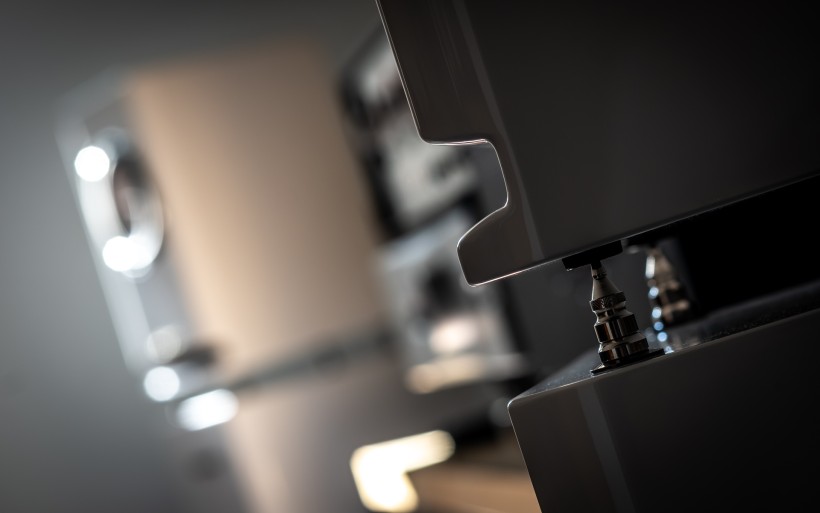 At camp Voxativ, semi-activism doesn’t diminish the prestige of their purely passive full-bandwidth specimens. Instead it greatly expands their abilities. The two-box Voxativ 9.87 system that had its official debut during High End Munich in 2015 comprised a standalone Pi monitor atop an active Pi-Bass module of a very niche RiPol pedigree that we’ll shortly get to. Most importantly, in this application Pi remained a fully passive unfiltered one-way with its widebander aroma undiluted and intact. The visually matched sub just extended the entire design’s reach on the bottom by a lot. Like so, back then Voxativ 9.87 proved us that achieving unfiltered widebander traits and deep bass from a visually classy reasonably sized speaker was possible. I’ve heard and immensely enjoyed this handsome devil in Munich in 2015. In October the same year Srajan reviewed and awarded it with his Blue Moon badge that had “Top-class full-bandwidth speaker of high efficiency” on it. In the following years, the 9.87 system had evolved into a three-box 9.88 affair that slotted a standalone rear-ported midrange module between Pi and RiPol sub. Crossovers were added, too. Priced at €79’900/pr, this still is the manufacturer’s current semi-active top dog. Today’s Voxativ Alberich2 system follows the same semi-active two-box protocol as the 9.87, but does so at a much lower cost and size. Prior to moving to this very special design, let’s tackle RiPol bass first.
At camp Voxativ, semi-activism doesn’t diminish the prestige of their purely passive full-bandwidth specimens. Instead it greatly expands their abilities. The two-box Voxativ 9.87 system that had its official debut during High End Munich in 2015 comprised a standalone Pi monitor atop an active Pi-Bass module of a very niche RiPol pedigree that we’ll shortly get to. Most importantly, in this application Pi remained a fully passive unfiltered one-way with its widebander aroma undiluted and intact. The visually matched sub just extended the entire design’s reach on the bottom by a lot. Like so, back then Voxativ 9.87 proved us that achieving unfiltered widebander traits and deep bass from a visually classy reasonably sized speaker was possible. I’ve heard and immensely enjoyed this handsome devil in Munich in 2015. In October the same year Srajan reviewed and awarded it with his Blue Moon badge that had “Top-class full-bandwidth speaker of high efficiency” on it. In the following years, the 9.87 system had evolved into a three-box 9.88 affair that slotted a standalone rear-ported midrange module between Pi and RiPol sub. Crossovers were added, too. Priced at €79’900/pr, this still is the manufacturer’s current semi-active top dog. Today’s Voxativ Alberich2 system follows the same semi-active two-box protocol as the 9.87, but does so at a much lower cost and size. Prior to moving to this very special design, let’s tackle RiPol bass first.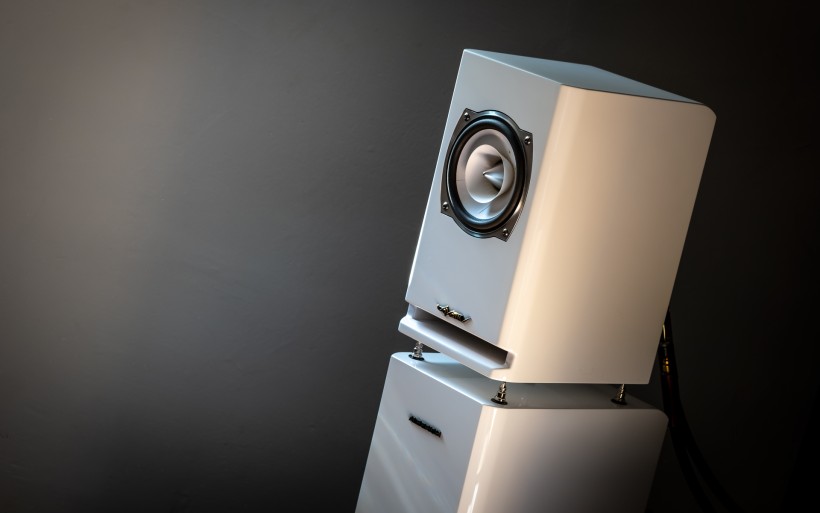 Full-range drivers tailored for horn loading and crossoverless work are speed freaks. Their extremely light cones, powerful motors and direct handshake with amps make it so. During the design stage of the Voxativ 9.87 system, Marie Adler deemed conventional subwoofers as too slow for the 99dB-efficient transducer in the Pi monitor. The efficiency gap between them had to be bridged. A much quicker bass bin took the form of a module based on the RiPol principle that was patented by Axel Ridthaler. In layman’s terms, if we fold a woofer on a baffle aka dipole bass into a frame with two large openings, one only for the cone’s front strokes and the other exclusively for its rear strokes, we effectively end up with a directional velocity converter that radiates like a cardioid; in phase mainly to the front and less to the back with phase inverted. The resulting lateral anti-phase cancellation invoked on the sides of the RiPol enclosure prevents it from triggering room gain that is reflective hence delayed. To simplify, bass from such a box interacts with our listening space far less than typical subs that are omnidirectional pressure generators. The lesser is this interaction, the quieter is this room and the cleaner bass output we get in return. Not only this, woofers inside ported and sealed subs also have to fight against the internal pressure buildup that makes their cabinets chattier and puts stress on drivers themselves. RiPol types don’t compress air because they’re open by design, so the entire energy that they create is released outside instead of being stored and transferred to their enclosures as unwanted resonances. In other words, RiPol boxes create rather nice environment for woofers and also don’t necessitate enormous cubic volume to secure their high damping and low resonant frequency. In short, they needn’t be big to act bold. While they function as bass providers, many folks would argue that they’re their own thing, not subs.
Full-range drivers tailored for horn loading and crossoverless work are speed freaks. Their extremely light cones, powerful motors and direct handshake with amps make it so. During the design stage of the Voxativ 9.87 system, Marie Adler deemed conventional subwoofers as too slow for the 99dB-efficient transducer in the Pi monitor. The efficiency gap between them had to be bridged. A much quicker bass bin took the form of a module based on the RiPol principle that was patented by Axel Ridthaler. In layman’s terms, if we fold a woofer on a baffle aka dipole bass into a frame with two large openings, one only for the cone’s front strokes and the other exclusively for its rear strokes, we effectively end up with a directional velocity converter that radiates like a cardioid; in phase mainly to the front and less to the back with phase inverted. The resulting lateral anti-phase cancellation invoked on the sides of the RiPol enclosure prevents it from triggering room gain that is reflective hence delayed. To simplify, bass from such a box interacts with our listening space far less than typical subs that are omnidirectional pressure generators. The lesser is this interaction, the quieter is this room and the cleaner bass output we get in return. Not only this, woofers inside ported and sealed subs also have to fight against the internal pressure buildup that makes their cabinets chattier and puts stress on drivers themselves. RiPol types don’t compress air because they’re open by design, so the entire energy that they create is released outside instead of being stored and transferred to their enclosures as unwanted resonances. In other words, RiPol boxes create rather nice environment for woofers and also don’t necessitate enormous cubic volume to secure their high damping and low resonant frequency. In short, they needn’t be big to act bold. While they function as bass providers, many folks would argue that they’re their own thing, not subs.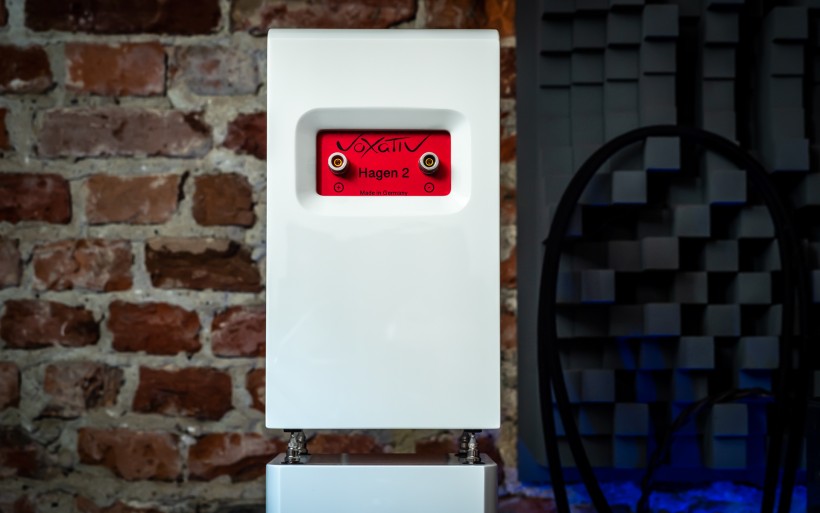 With that out of the way, let’s go back to the 9.87 project. Two customized 12″ pro-audio woofers of 96dB efficiency per channel in a RiPol frame allowed Marie to land a bass module that packed all the traits as explained above, removed reactive box talk from the equation and upped its efficiency by 3dB, so it nicely matched 99dBs of Pi’s own driver. The internal 250wpc class-AB plate amp made it work. No wonder the 9.87 system got Srajan’s award. Not only it fully solved arguably the biggest challenge for widebanders, that would be bass reach, but it also did this in style that pleased many décor-sensitive eyes. As far as I could tell, this was the first commercial effort that combined the already niche full-range drivers with extremely rare RiPol subs. Until recently it was also the only one. Known speaker makers who pursue this kind of bass are far and few between, there’s probably less than a dozen of them. Why this is the case, I have no clue. The RiPol patent expired years ago and Srajan’s been one avid enthusiast of this principle for years. After guesting the Alberich2 system for several very enjoyable weeks, I think I know why. This review kicked off with Duo SD as the spark that irreversibly altered my view on semi-active speakers. As one of them, Voxativ Alberich2 is just as clever common-sense trooper. Packed with RiPol bins and full-rangers instead of horns and sealed woofers, it represents an effort very much up my alley. Beyond the Voxativ roster there’s also nothing like it on the market right now. Recently Srajan awarded Alberich2 with his Lunar Eclipse badge that we see about once per year at best. Then Marie was game on forwarding his loaner set my way. Happy days!
With that out of the way, let’s go back to the 9.87 project. Two customized 12″ pro-audio woofers of 96dB efficiency per channel in a RiPol frame allowed Marie to land a bass module that packed all the traits as explained above, removed reactive box talk from the equation and upped its efficiency by 3dB, so it nicely matched 99dBs of Pi’s own driver. The internal 250wpc class-AB plate amp made it work. No wonder the 9.87 system got Srajan’s award. Not only it fully solved arguably the biggest challenge for widebanders, that would be bass reach, but it also did this in style that pleased many décor-sensitive eyes. As far as I could tell, this was the first commercial effort that combined the already niche full-range drivers with extremely rare RiPol subs. Until recently it was also the only one. Known speaker makers who pursue this kind of bass are far and few between, there’s probably less than a dozen of them. Why this is the case, I have no clue. The RiPol patent expired years ago and Srajan’s been one avid enthusiast of this principle for years. After guesting the Alberich2 system for several very enjoyable weeks, I think I know why. This review kicked off with Duo SD as the spark that irreversibly altered my view on semi-active speakers. As one of them, Voxativ Alberich2 is just as clever common-sense trooper. Packed with RiPol bins and full-rangers instead of horns and sealed woofers, it represents an effort very much up my alley. Beyond the Voxativ roster there’s also nothing like it on the market right now. Recently Srajan awarded Alberich2 with his Lunar Eclipse badge that we see about once per year at best. Then Marie was game on forwarding his loaner set my way. Happy days!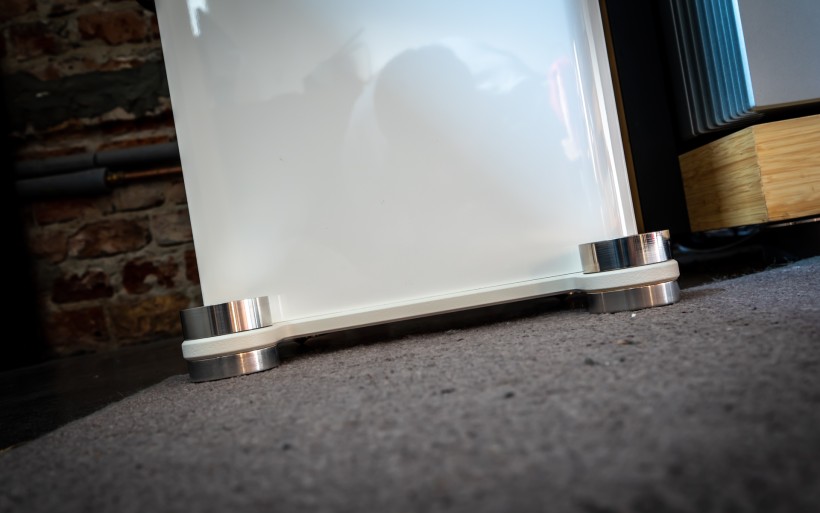 The cargo from Ireland comprised three boxes on a pallet. Hagen2 monitors in-between foamy liners shared one cardboard and each sub enjoyed its own. Unpacking and putting these contents together was easily a one-man job. Sundry accessories included only eight spikes that mount atop bass bins. Nothing else was necessary. On-site specs list 20Hz – 33kHz frequency response, 20 x 105 x 30cm (W x D x H) size and 46,6kg mass per each assembled speaker. Sensitivity stretches from 93 to 98dB (@1W/1m) and depends on the selected full-bandwidth driver. Voxativ AF-1.9 is rated at 95dB, while AF-2A/2B units secure 93/98dB respectively. I notice that since Srajan’s review a month ago, the price has increased more than 10% likely in response to Trump’s tariffs. Now Alberich2 with AF-1.9 sells for €19’900/pr and AF-2A/2B drivers add €3’000/8’000 to the bill. Gloss black finish is included in the price, gloss white wants €1’000 extra and any other color will set you back €4’000. Quick math tells us that the loaner as reviewed (gloss white with AF-2A drivers) is €23’900/pr. While that’s plenty posh already, the Alberich2 dressed up in raw/polished/anodized aluminium with AF-2A drivers is priced at €36’900/pr. We’re not at the top just yet. The 101dB-efficient Alberich2 Array system that docks up to four (!!!) Hagen2 monitors on a single RiPol sub per channel is a €60’900/pr expense. Should we think that these are steep prices, well, they are. Then again, Voxativ is and has always been a luxo house that makes their own boutique drivers and pretty much all else in Berlin.
The cargo from Ireland comprised three boxes on a pallet. Hagen2 monitors in-between foamy liners shared one cardboard and each sub enjoyed its own. Unpacking and putting these contents together was easily a one-man job. Sundry accessories included only eight spikes that mount atop bass bins. Nothing else was necessary. On-site specs list 20Hz – 33kHz frequency response, 20 x 105 x 30cm (W x D x H) size and 46,6kg mass per each assembled speaker. Sensitivity stretches from 93 to 98dB (@1W/1m) and depends on the selected full-bandwidth driver. Voxativ AF-1.9 is rated at 95dB, while AF-2A/2B units secure 93/98dB respectively. I notice that since Srajan’s review a month ago, the price has increased more than 10% likely in response to Trump’s tariffs. Now Alberich2 with AF-1.9 sells for €19’900/pr and AF-2A/2B drivers add €3’000/8’000 to the bill. Gloss black finish is included in the price, gloss white wants €1’000 extra and any other color will set you back €4’000. Quick math tells us that the loaner as reviewed (gloss white with AF-2A drivers) is €23’900/pr. While that’s plenty posh already, the Alberich2 dressed up in raw/polished/anodized aluminium with AF-2A drivers is priced at €36’900/pr. We’re not at the top just yet. The 101dB-efficient Alberich2 Array system that docks up to four (!!!) Hagen2 monitors on a single RiPol sub per channel is a €60’900/pr expense. Should we think that these are steep prices, well, they are. Then again, Voxativ is and has always been a luxo house that makes their own boutique drivers and pretty much all else in Berlin.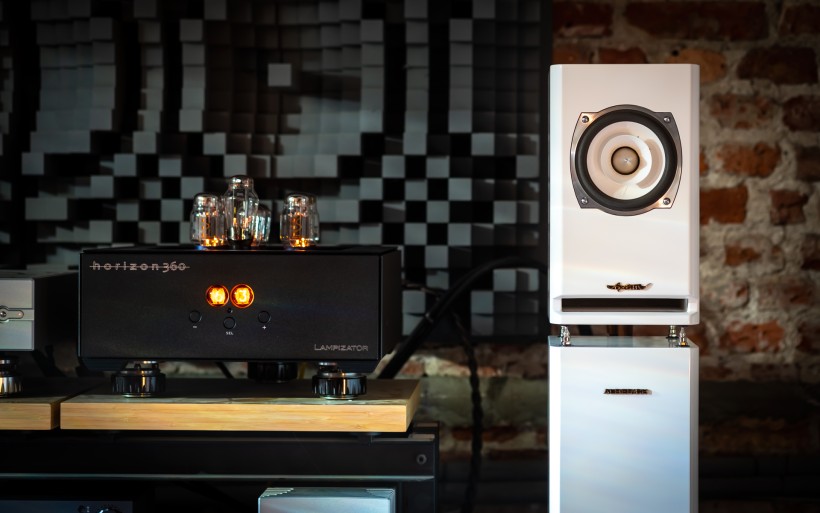 Standalone Hagen2 monitors available at the manufacturer’s site aren’t the same as their version used in the Alberich2 system. Its upper Hagen2 residents had their internal tunnels modified to cut off at 90Hz, reinforce their 100-300Hz presence, integrate better with RiPol subs and secure better overall sound quality. After all, why bother and oftentimes struggle with a widebander’s extension on the bottom if the bin below it is better for the job anyway? I also imagine that AF-2A drivers rolled off this high have their motors cruising not sweating and that’s always nice for their linearity and distortion figures. Moving on, Hagen2’s intentionally not smooth rear-horn loading dubbed AST (Acoustic Stealtch Technology) was designed to pass desirable sound reflections and prevent those that are unwanted. To achieve this filtering effect, precise calculations and alignment of panels that form Hagen2’s internal tunnels had to be made. As for the Voxativ AF-2A 5″ driver, it rocks a paper cone, paper whizzer and rarely seen costly AlNiCo motor. Each RiPol sub incorporates a single 12″ woofer on a 500W class-D plate amp with the main on/off rocker, fused IEC inlet, one of each RCA line-level inputs and outputs plus three essential knobs that regulate phase (0-180°), woofer cut-off frequency (40-200Hz) and volume level. Marie informed me that low pass at 85Hz and 90° phase should be a good starting point. My final settings were in that ballpark. The volume knob proved very hot, in the sense that going mildly above the lowest setting already produced very high bass output. I don’t know whether this was intentional behavior or not. Perhaps in rooms larger than mine it would be of use. In mine however going past 1/5th of the total scale was not needed.
Standalone Hagen2 monitors available at the manufacturer’s site aren’t the same as their version used in the Alberich2 system. Its upper Hagen2 residents had their internal tunnels modified to cut off at 90Hz, reinforce their 100-300Hz presence, integrate better with RiPol subs and secure better overall sound quality. After all, why bother and oftentimes struggle with a widebander’s extension on the bottom if the bin below it is better for the job anyway? I also imagine that AF-2A drivers rolled off this high have their motors cruising not sweating and that’s always nice for their linearity and distortion figures. Moving on, Hagen2’s intentionally not smooth rear-horn loading dubbed AST (Acoustic Stealtch Technology) was designed to pass desirable sound reflections and prevent those that are unwanted. To achieve this filtering effect, precise calculations and alignment of panels that form Hagen2’s internal tunnels had to be made. As for the Voxativ AF-2A 5″ driver, it rocks a paper cone, paper whizzer and rarely seen costly AlNiCo motor. Each RiPol sub incorporates a single 12″ woofer on a 500W class-D plate amp with the main on/off rocker, fused IEC inlet, one of each RCA line-level inputs and outputs plus three essential knobs that regulate phase (0-180°), woofer cut-off frequency (40-200Hz) and volume level. Marie informed me that low pass at 85Hz and 90° phase should be a good starting point. My final settings were in that ballpark. The volume knob proved very hot, in the sense that going mildly above the lowest setting already produced very high bass output. I don’t know whether this was intentional behavior or not. Perhaps in rooms larger than mine it would be of use. In mine however going past 1/5th of the total scale was not needed.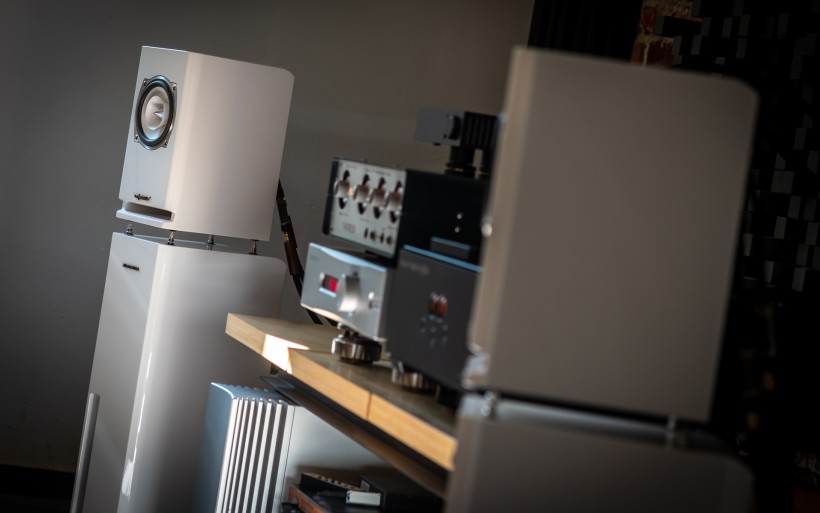 Those who understand how posh and unusual are the means that make Alberich2 may agree that its dress code is one of the key attractors. In that sense, this is a regularly shaped and sized speaker. Pondering about the idea of augmenting a full-fledged crossoverless widebander with RiPol bass is one thing, making it come to life in a small frame this small is another. The 9.87 system was far larger after all. Alberich2 being its more compact and cost-effective relative scores even higher on domestication and accessibility. Subtly curved surfaces on the upper and lower enclosure, both made of MDF btw., also make it very nice to look at. While the bass bin is a bit deeper than the upper box, the former’s sloped top nicely offsets the difference and connects them into a visually attractive and coherent structure. Four knurled spikes that thread into the sub to accommodate Hagen2 are too tall to my taste. I’m not a fan of what they do to sound either. On the upside, bass bins can easily accept something shorter. The two cabinets also look arguably better with some space between them and pointy separators included in the set get us there. The rest is in the eye of the beholder. Since we’re at styling, I particularly fancied beefy outriggers under subs and how they made the product visually more robust. Their shiny footers with short spikes underneath don’t provide any height regulation however, so early on speaker wobble was a thing even on my concrete floor. I sorted that snafu by using four tiny sound|kaos Vibra30 wire suspenders under each sub. The manufacturer is aware of the issue and the fix without revamping the current pucks seems simple, so that’s that. Voxativ designs are known for perfect paint job and overall finish to a very high standard. While externally Alberich2 isn’t any different on that front, its white slotted horn mouths and woofer openings are more liberal on that score. From the listening seat this doesn’t show, up close it does. Shoppers sensitive about cosmetics would appreciate masking inserts for these openings. Lastly, Ripol subs with two woofers facing one another in the same cabinet as in the 9.87 system are known as BMS. The DMS version as used in Alberich2 relies on just one driver that’s vented accordingly to the same RiPol principle and behaviorally alike. While a single such woofer has lower output than two, it also wants less space. Considering how sleek and compact today’s speaker set is, this was the right call. Besides, on duties downstairs it’s already fiendish as is.
Those who understand how posh and unusual are the means that make Alberich2 may agree that its dress code is one of the key attractors. In that sense, this is a regularly shaped and sized speaker. Pondering about the idea of augmenting a full-fledged crossoverless widebander with RiPol bass is one thing, making it come to life in a small frame this small is another. The 9.87 system was far larger after all. Alberich2 being its more compact and cost-effective relative scores even higher on domestication and accessibility. Subtly curved surfaces on the upper and lower enclosure, both made of MDF btw., also make it very nice to look at. While the bass bin is a bit deeper than the upper box, the former’s sloped top nicely offsets the difference and connects them into a visually attractive and coherent structure. Four knurled spikes that thread into the sub to accommodate Hagen2 are too tall to my taste. I’m not a fan of what they do to sound either. On the upside, bass bins can easily accept something shorter. The two cabinets also look arguably better with some space between them and pointy separators included in the set get us there. The rest is in the eye of the beholder. Since we’re at styling, I particularly fancied beefy outriggers under subs and how they made the product visually more robust. Their shiny footers with short spikes underneath don’t provide any height regulation however, so early on speaker wobble was a thing even on my concrete floor. I sorted that snafu by using four tiny sound|kaos Vibra30 wire suspenders under each sub. The manufacturer is aware of the issue and the fix without revamping the current pucks seems simple, so that’s that. Voxativ designs are known for perfect paint job and overall finish to a very high standard. While externally Alberich2 isn’t any different on that front, its white slotted horn mouths and woofer openings are more liberal on that score. From the listening seat this doesn’t show, up close it does. Shoppers sensitive about cosmetics would appreciate masking inserts for these openings. Lastly, Ripol subs with two woofers facing one another in the same cabinet as in the 9.87 system are known as BMS. The DMS version as used in Alberich2 relies on just one driver that’s vented accordingly to the same RiPol principle and behaviorally alike. While a single such woofer has lower output than two, it also wants less space. Considering how sleek and compact today’s speaker set is, this was the right call. Besides, on duties downstairs it’s already fiendish as is.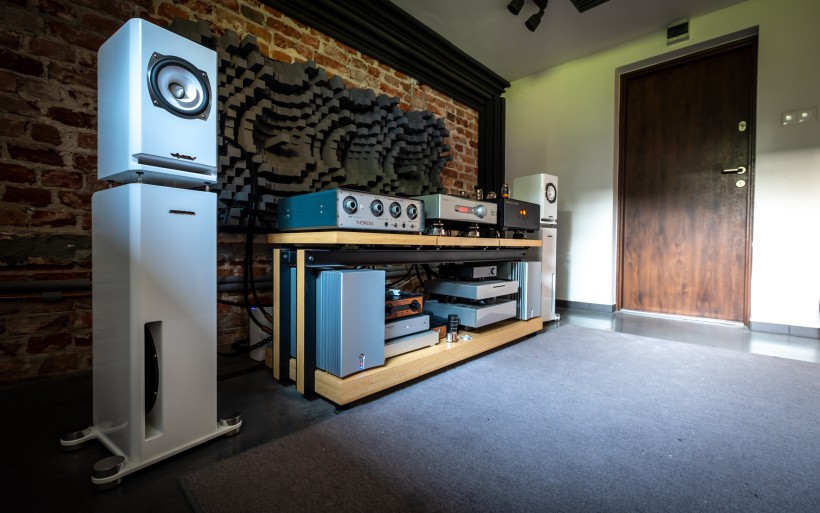 First things first. Positioning, suitable amps and listening were on the priority list and in that order. To invoke the sidewall cancellation effect and reap associated benefits, RiPol subs don’t want to be glued to the front wall. I had zero intentions to do so anyway. In general, the greater is the distance between speakers and this surface, the more developed they become on spatial depth. This is precisely why I position Vox monitors almost in the middle of my room and toe them aggressively to cross on my head. Then I get to enjoy their headphone-like imaging that locks me in a spatial bubble of sorts. While paper cones of these Swiss petites allow for that, there’s one extra factor. Vox are shorties. Their Enviée drivers sit a bit lower than my ears and fire at them from down below. Voxativ Alberich2 is a much taller speaker set, so I’d have to sit much higher to use it like the Vox and tap into the same spatially enveloping sensation. Neither I had a bar stool nor larger listening room to do that. No matter. While my photos don’t show, today’s floorstander set had about two meters to the front wall and and crossed roughly at the listening seat. That worked like a treat. Alberich2 used like so was amazing on spatial qualities without any ifs or buts. Here I should say that it also did very well barely toed in and one meter closer to the front wall. Upon setting it up like so, most listeners would be very happy about the outcome. I have my habits however and these die hard. If a prospect of tapping into that bubble-like aural sensation is there, I’ll gladly pursue it.
First things first. Positioning, suitable amps and listening were on the priority list and in that order. To invoke the sidewall cancellation effect and reap associated benefits, RiPol subs don’t want to be glued to the front wall. I had zero intentions to do so anyway. In general, the greater is the distance between speakers and this surface, the more developed they become on spatial depth. This is precisely why I position Vox monitors almost in the middle of my room and toe them aggressively to cross on my head. Then I get to enjoy their headphone-like imaging that locks me in a spatial bubble of sorts. While paper cones of these Swiss petites allow for that, there’s one extra factor. Vox are shorties. Their Enviée drivers sit a bit lower than my ears and fire at them from down below. Voxativ Alberich2 is a much taller speaker set, so I’d have to sit much higher to use it like the Vox and tap into the same spatially enveloping sensation. Neither I had a bar stool nor larger listening room to do that. No matter. While my photos don’t show, today’s floorstander set had about two meters to the front wall and and crossed roughly at the listening seat. That worked like a treat. Alberich2 used like so was amazing on spatial qualities without any ifs or buts. Here I should say that it also did very well barely toed in and one meter closer to the front wall. Upon setting it up like so, most listeners would be very happy about the outcome. I have my habits however and these die hard. If a prospect of tapping into that bubble-like aural sensation is there, I’ll gladly pursue it.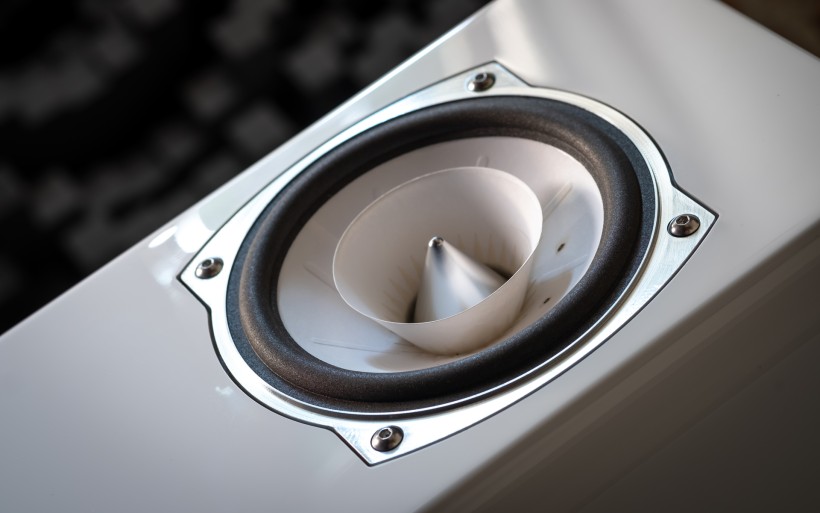 Amplification suitable for widebanders primed for going solo is no rocket science. In short, these delicate drivers hate being overdamped. Should we do that, they become tonally frosty, piercing, thin, whitish, nervous, grainy, shouty and dry. This is precisely why companion amps with very high output Ω are the ticket. Low-power DHT tube designs and specialist single-stage class A transistor types fit the profile. Beefy class D and class AB machines designed to control tough speakers do not. To put this into perspective, the lower is the amplifier’s damping factor with Alberich2’s AF-2A drivers rated at 10,3Ω, the better sound these full-rangers will make. Any amp capable of securing the ideal value of 1 wouldn’t damp these drivers at all, in the sense that it wouldn’t provide any braking for their back EMF (electromotive force). When a full-range transducer can stop on its own, then it becomes the opposite of dry and its most desirable sonic traits fully flourish and sophisitication unfolds. The remarkable FirstWatt SIT-4 would multiply our ideal DF (damping factor) figure of 1 by x2,5, which is enjoyably low. Sundry amps I had access to were nowhere near. Trilogy 995R monos scored about 20 or so and that was already too high to my taste. FirstWatt F7 cranked that number up to nearly 130. Enleum AMP-23R was the saving grace that secured comfortable 13. While the stopping power of this tiny integrated machine was five times higher than the SIT-4’s, it did very well with today’s load. While Srajan found the Enleum too icy for Alberich2, he had a feeling that a preamp groomed for high color and density would potentially elevate the South Korean. I saw the logic in this. The man runs his amps either from passive inherently lean autoformer regulators with in-built hi/lo-pass filters, or directly from his DACs’ variable outputs. While he doesn’t use actively buffered preamps, he predicted that fronting my AMP-23R with tubed Thöress DFP could net some good results. Spot on. This was the best combo I was able to put together from all the building blocks I had at my disposal.
Amplification suitable for widebanders primed for going solo is no rocket science. In short, these delicate drivers hate being overdamped. Should we do that, they become tonally frosty, piercing, thin, whitish, nervous, grainy, shouty and dry. This is precisely why companion amps with very high output Ω are the ticket. Low-power DHT tube designs and specialist single-stage class A transistor types fit the profile. Beefy class D and class AB machines designed to control tough speakers do not. To put this into perspective, the lower is the amplifier’s damping factor with Alberich2’s AF-2A drivers rated at 10,3Ω, the better sound these full-rangers will make. Any amp capable of securing the ideal value of 1 wouldn’t damp these drivers at all, in the sense that it wouldn’t provide any braking for their back EMF (electromotive force). When a full-range transducer can stop on its own, then it becomes the opposite of dry and its most desirable sonic traits fully flourish and sophisitication unfolds. The remarkable FirstWatt SIT-4 would multiply our ideal DF (damping factor) figure of 1 by x2,5, which is enjoyably low. Sundry amps I had access to were nowhere near. Trilogy 995R monos scored about 20 or so and that was already too high to my taste. FirstWatt F7 cranked that number up to nearly 130. Enleum AMP-23R was the saving grace that secured comfortable 13. While the stopping power of this tiny integrated machine was five times higher than the SIT-4’s, it did very well with today’s load. While Srajan found the Enleum too icy for Alberich2, he had a feeling that a preamp groomed for high color and density would potentially elevate the South Korean. I saw the logic in this. The man runs his amps either from passive inherently lean autoformer regulators with in-built hi/lo-pass filters, or directly from his DACs’ variable outputs. While he doesn’t use actively buffered preamps, he predicted that fronting my AMP-23R with tubed Thöress DFP could net some good results. Spot on. This was the best combo I was able to put together from all the building blocks I had at my disposal.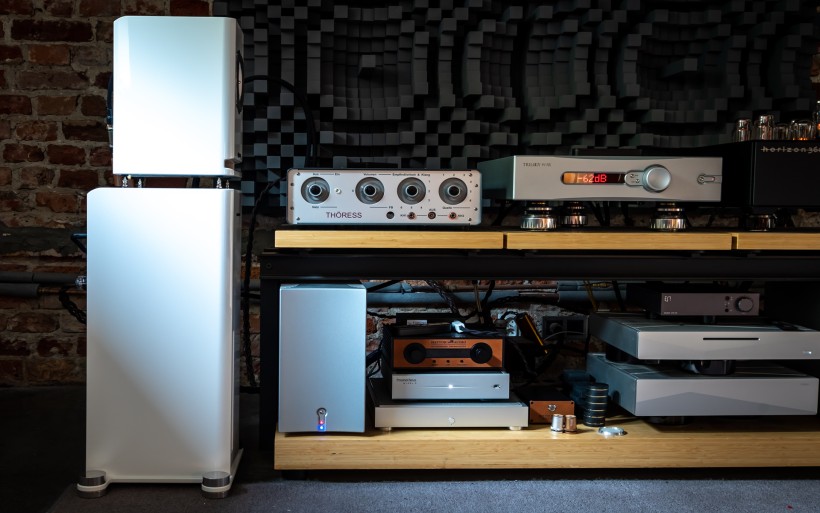 The correct amp type aside, the upper Alberich2 boxes need only speaker cables. Each bass bin naturally requires a power cord and line-level signal supplied via RCA leash from the device upstream. While this is not a tall order by any stretch, an integrated amplifier or pre of our choice has to allow for this and not all can. Now we can finally move to sonics. Considering the key means this report’s speaker set packs, let’s first tackle its bass, then what happens when it combines with the range above. To kick off, in my Duo SD review I wrote that… “it quickly became clear that most conventional passive speakers can’t compete with the Duo SD on bass in my listening room. Vented products designed for smaller spaces neither will dig as deep nor land bass blows from the lowest depths with the same ease. They also won’t be as agile, direct, controlled and simultaneously as accommodating to room resonances. To illustrate what I mean, years ago I picked up one trick from Srajan that includes the track “Gold Dust Bacchanalia” from Mychael Danna’s soundtrack for the movie “Kamasutra”. Around the 40-second mark, content around +/- 25Hz kicks in, which we feel rather than hear it. Though most speakers, including my daily drivers, won’t reproduce that, they will leave the listener with the irresistible impression that something should be there. The Duo SD showed exactly what it is: lively, physically sensible vibrations and rumblings that drift through the listening room, shaking it and causing it to pleasantly rumble without any signs of boom, sluggishness, or chaos. I could count on one hand speakers I’ve tested in the past that were capable of reproducing this feeling with comparable intensity. It’s a bit of a shame. A lot of electronic music features parts below 30Hz, so it would be great to always have access to them. Just to give two additional examples, the track “Queen Mary” by Francine Thirteen demonstrates this as well and so does “Inchworm” by Battles. The takeaway is clear. If speakers even larger than the Duo SD are not allowed, we need specific and – let’s be honest – active measures to keep up with their bass.”
The correct amp type aside, the upper Alberich2 boxes need only speaker cables. Each bass bin naturally requires a power cord and line-level signal supplied via RCA leash from the device upstream. While this is not a tall order by any stretch, an integrated amplifier or pre of our choice has to allow for this and not all can. Now we can finally move to sonics. Considering the key means this report’s speaker set packs, let’s first tackle its bass, then what happens when it combines with the range above. To kick off, in my Duo SD review I wrote that… “it quickly became clear that most conventional passive speakers can’t compete with the Duo SD on bass in my listening room. Vented products designed for smaller spaces neither will dig as deep nor land bass blows from the lowest depths with the same ease. They also won’t be as agile, direct, controlled and simultaneously as accommodating to room resonances. To illustrate what I mean, years ago I picked up one trick from Srajan that includes the track “Gold Dust Bacchanalia” from Mychael Danna’s soundtrack for the movie “Kamasutra”. Around the 40-second mark, content around +/- 25Hz kicks in, which we feel rather than hear it. Though most speakers, including my daily drivers, won’t reproduce that, they will leave the listener with the irresistible impression that something should be there. The Duo SD showed exactly what it is: lively, physically sensible vibrations and rumblings that drift through the listening room, shaking it and causing it to pleasantly rumble without any signs of boom, sluggishness, or chaos. I could count on one hand speakers I’ve tested in the past that were capable of reproducing this feeling with comparable intensity. It’s a bit of a shame. A lot of electronic music features parts below 30Hz, so it would be great to always have access to them. Just to give two additional examples, the track “Queen Mary” by Francine Thirteen demonstrates this as well and so does “Inchworm” by Battles. The takeaway is clear. If speakers even larger than the Duo SD are not allowed, we need specific and – let’s be honest – active measures to keep up with their bass.”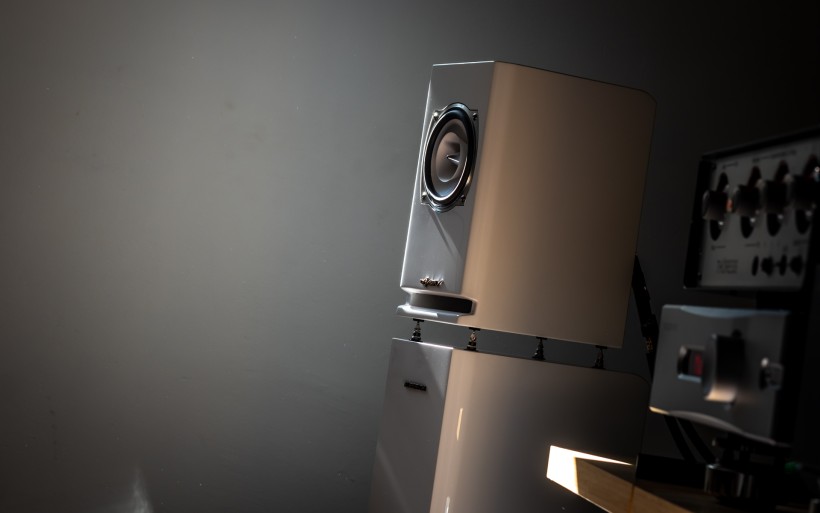 On bass extension alone, Voxativ Alberich2 was as superb as Duo SD and behaved with alike ease. After experiencing how it fared in this regard, I imagine that many listeners would turn and scratch their heads in disbelief how a speaker of this size can pull such bass. Those into electronic music genres would find it enormously useful I’m sure. I know I did. RiPol subs however really are their own thing. We got so used to bass boom, chunk, smear and drag as byproducts of port farts and room talk, that we take them as vital parts of the picture without even knowing. Alberich2 shows us how it looks like when they’re not there. Most importantly, only by subtraction we can learn that these non-essentials often framed into politically correct words such as meatiness are in fact proper troublemakers that should always be gone. Without prior exposure to dipole bass, at first Alberich2’s subs may seem too sterile and missing something somewhere. While that’s not the case, there’s a learning curve to their sound. Past the introductory courtesies we acknowledge that their output is predominantly fit; highly articulated, precise, dynamic and very fast indeed. Then this kind of bass no longer seems dry and off in some weirdly untraceable way, but color-wise spot on, wondrously elastic, responsive, meticulous, enormously powerful, majestic, very clean in its delivery and all in all gorgeous. Let’s inhale, exhale, enjoy the sensation for a while and then return to non-RiPol speakers. Oops, it’s more challenging and difficult than we’d like. Too late, we should’ve read the label first. This RiPol thing is some seriously potent highly addictive stuff. It honestly doesn’t take much to get hooked.
On bass extension alone, Voxativ Alberich2 was as superb as Duo SD and behaved with alike ease. After experiencing how it fared in this regard, I imagine that many listeners would turn and scratch their heads in disbelief how a speaker of this size can pull such bass. Those into electronic music genres would find it enormously useful I’m sure. I know I did. RiPol subs however really are their own thing. We got so used to bass boom, chunk, smear and drag as byproducts of port farts and room talk, that we take them as vital parts of the picture without even knowing. Alberich2 shows us how it looks like when they’re not there. Most importantly, only by subtraction we can learn that these non-essentials often framed into politically correct words such as meatiness are in fact proper troublemakers that should always be gone. Without prior exposure to dipole bass, at first Alberich2’s subs may seem too sterile and missing something somewhere. While that’s not the case, there’s a learning curve to their sound. Past the introductory courtesies we acknowledge that their output is predominantly fit; highly articulated, precise, dynamic and very fast indeed. Then this kind of bass no longer seems dry and off in some weirdly untraceable way, but color-wise spot on, wondrously elastic, responsive, meticulous, enormously powerful, majestic, very clean in its delivery and all in all gorgeous. Let’s inhale, exhale, enjoy the sensation for a while and then return to non-RiPol speakers. Oops, it’s more challenging and difficult than we’d like. Too late, we should’ve read the label first. This RiPol thing is some seriously potent highly addictive stuff. It honestly doesn’t take much to get hooked.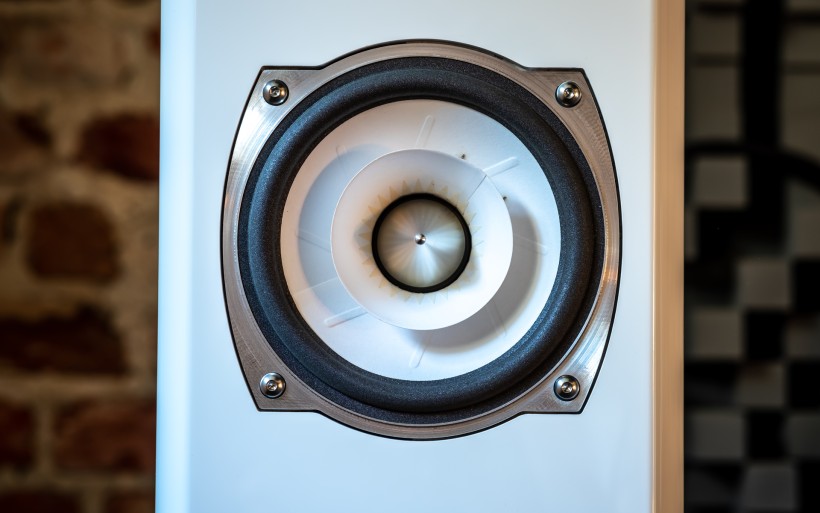 Now it may seem odd that early on in this review I gushed over how accomplished Duo ST speakers were on tasks downstairs. As a semi-active affair with sealed bass built upon 12” hard-hung pro-audio woofers armed with enormous voice coils, it truly was. Then again, I couldn’t have predicted that Alberich2 would be so different and groomed to please me even more. While I couldn’t compare them side by side, the white set arrived mere one week past Duo SD’s departure and was auditioned with the same music. On bottom reach it followed suit without miss, on bottom fill it was leaner yet struck me as still quicker, more immediate, cleaner and less dependent on room acoustics. Above the lowest two octaves Alberich2’s hard-hitting artillery would render Duo SD as a touch calmer, softer and bloomier, even though its bass is not that per se. Context matters. Here preferences would and should, too. I lean towards thinking that most listeners would enjoy Duo SD bass more. To them, it would simply feel more familiar and in line with what they’re used to. While plenty quick and feisty, it would also feel sensibly denser and earthlier in comparison to today’s extremely sporty rapid twin RiPol subs. Against most regular speakers Duo SD would also rather easily position far higher in terms of overall bass quality. However, dipole aesthetic has the upper hand in listening spaces with poor acoustics, which is yet another reason why bass proposed by Voxativ speaks to me even more than Duo SD’s already very gifted sealed modules. While very rare, in that sense this is a more practical method to pursue. Lest not forget that a classic dipole speaker capable of digging as deep as Alberich2 would necessitate a monstrous woofer or two in a correspondingly large frame. That today’s speaker set handles that frequency range as portrayed yet deliberately dresses in typical floorstander threads is its most mental virtue. Although Srajan already mentioned it, let me also stress the sidewall cancellation baked into this design effectively makes it a room-treatment sort of a deal. As far as objective bass qualities are concerned, it’s accurate that it will outmatch other non-dipole speakers in spaces without bass traps and the like.
Now it may seem odd that early on in this review I gushed over how accomplished Duo ST speakers were on tasks downstairs. As a semi-active affair with sealed bass built upon 12” hard-hung pro-audio woofers armed with enormous voice coils, it truly was. Then again, I couldn’t have predicted that Alberich2 would be so different and groomed to please me even more. While I couldn’t compare them side by side, the white set arrived mere one week past Duo SD’s departure and was auditioned with the same music. On bottom reach it followed suit without miss, on bottom fill it was leaner yet struck me as still quicker, more immediate, cleaner and less dependent on room acoustics. Above the lowest two octaves Alberich2’s hard-hitting artillery would render Duo SD as a touch calmer, softer and bloomier, even though its bass is not that per se. Context matters. Here preferences would and should, too. I lean towards thinking that most listeners would enjoy Duo SD bass more. To them, it would simply feel more familiar and in line with what they’re used to. While plenty quick and feisty, it would also feel sensibly denser and earthlier in comparison to today’s extremely sporty rapid twin RiPol subs. Against most regular speakers Duo SD would also rather easily position far higher in terms of overall bass quality. However, dipole aesthetic has the upper hand in listening spaces with poor acoustics, which is yet another reason why bass proposed by Voxativ speaks to me even more than Duo SD’s already very gifted sealed modules. While very rare, in that sense this is a more practical method to pursue. Lest not forget that a classic dipole speaker capable of digging as deep as Alberich2 would necessitate a monstrous woofer or two in a correspondingly large frame. That today’s speaker set handles that frequency range as portrayed yet deliberately dresses in typical floorstander threads is its most mental virtue. Although Srajan already mentioned it, let me also stress the sidewall cancellation baked into this design effectively makes it a room-treatment sort of a deal. As far as objective bass qualities are concerned, it’s accurate that it will outmatch other non-dipole speakers in spaces without bass traps and the like.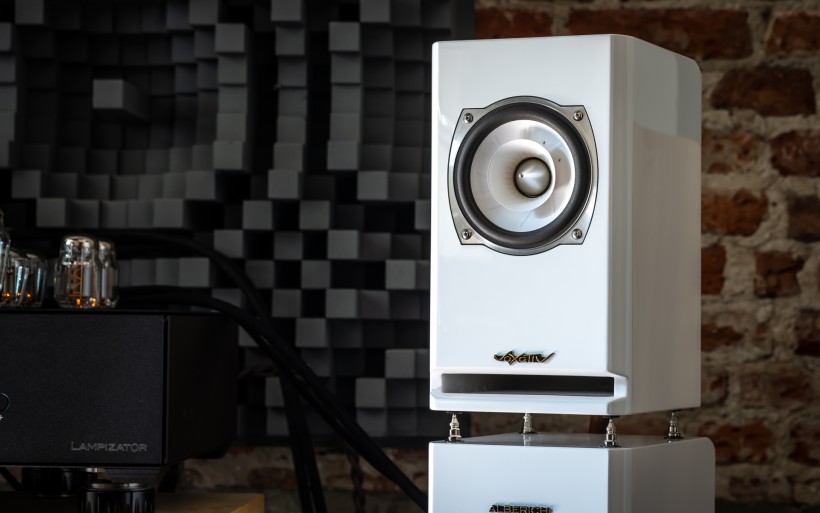 Suffice it to say, Voxativ Alberich2 handled bass in a remarkable, wholly positive and very much unique way. In this particular regard, I honestly failed to see any downsides to it. How this speaker set fared above bass proved predictable and also accomplished. I know quite a few multi-ways that are superb on imaging precision and other spatial stuff. Many compact two-way monitors act very much like point-source propagators that inherently excel at such tasks. Squeeze inside a bookshelf warrior a full-range driver that does most of the work and it’ll up that ante even more. In my roster, sound|kaos Vox 3afw represents peak performance here. I know of no other design that would do what these unique petites do imaging wise. If they ever get outclassed, most likely another widebander type will achieve this feat. There are however many speakers which I rate as high on core full-range values. Alberich2 is one of them. With just the right amp, this specimen blends generous illumination, air amount, detail retrieval, insight, directness, accuracy, freshness, quickness and timing with sound that’s persuasive, seductive, sensual, packed with fruity colors and here. This was all expected given the driver kind today’s 5-inchers represent. Users used to darkish voicing built upon density, voluptuous instrumental and vocal frames, tonal warmth, intimate imaging and autumn atmosphere will most certainly find Alberich2 unusually speedy, open, communicative, specific, shiny, contrasting, detailed, sunny and happy. As such, it lets in loads of fresh air and offers spring season on its best day. That’s the rough guideline. Also, the seam between Alberich2’s upper and lower box was undetectable to my ears. No wonder, its speedy crossoverless drivers worked alongside RiPol subs very much alike in this regard.
Suffice it to say, Voxativ Alberich2 handled bass in a remarkable, wholly positive and very much unique way. In this particular regard, I honestly failed to see any downsides to it. How this speaker set fared above bass proved predictable and also accomplished. I know quite a few multi-ways that are superb on imaging precision and other spatial stuff. Many compact two-way monitors act very much like point-source propagators that inherently excel at such tasks. Squeeze inside a bookshelf warrior a full-range driver that does most of the work and it’ll up that ante even more. In my roster, sound|kaos Vox 3afw represents peak performance here. I know of no other design that would do what these unique petites do imaging wise. If they ever get outclassed, most likely another widebander type will achieve this feat. There are however many speakers which I rate as high on core full-range values. Alberich2 is one of them. With just the right amp, this specimen blends generous illumination, air amount, detail retrieval, insight, directness, accuracy, freshness, quickness and timing with sound that’s persuasive, seductive, sensual, packed with fruity colors and here. This was all expected given the driver kind today’s 5-inchers represent. Users used to darkish voicing built upon density, voluptuous instrumental and vocal frames, tonal warmth, intimate imaging and autumn atmosphere will most certainly find Alberich2 unusually speedy, open, communicative, specific, shiny, contrasting, detailed, sunny and happy. As such, it lets in loads of fresh air and offers spring season on its best day. That’s the rough guideline. Also, the seam between Alberich2’s upper and lower box was undetectable to my ears. No wonder, its speedy crossoverless drivers worked alongside RiPol subs very much alike in this regard.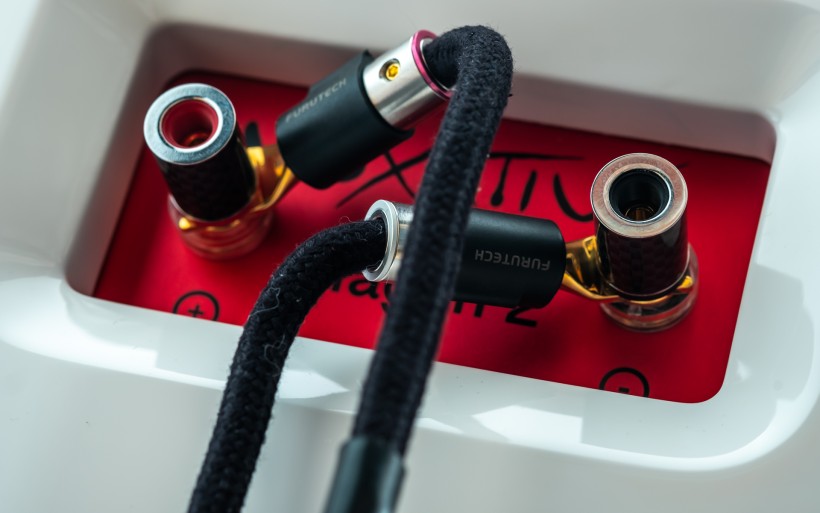 It’s only fair to say that qualities baked into the upper Alberich2 boxes and Vox monitors largely overlapped. Although the former was a touch leaner and shinier of the two, it wouldn’t have been if I had an even more suitable companion amp for it. Vox monitors used as near-field types in my room also had a slight edge on that spatially enveloping sound that I thoroughly enjoy. Their supportive Raal ribbons also extended the brilliance region a notch and revealed more transient-related info, too. While all these changes registered, their magnitude was minor and certainly beyond the key focal point where Alberich2 had its sweet revenge. Should we agree that floorstanders can’t conjure up monitor imaging precision and monitors can’t compete with them on bass, dynamic span and scale, than today’s sleek German performer did the unthinkable. It made just the sound we’d want from a full-blooded specialist monitor with a very posh driver that’s been primed for x-overless work. It also executed this task to a very high standard as it turned out. Then on bass it proved far more accomplished that most floorstanders I’ve tackled over the years… which is quite insane when I think about it. Voxativ Alberich2 boasts not only the best monitor strengths and does what their kind can’t do, but on bass it also will beat most full-sized designs in their own game with disturbing ease. Let that sink in. Let’s wrap.
It’s only fair to say that qualities baked into the upper Alberich2 boxes and Vox monitors largely overlapped. Although the former was a touch leaner and shinier of the two, it wouldn’t have been if I had an even more suitable companion amp for it. Vox monitors used as near-field types in my room also had a slight edge on that spatially enveloping sound that I thoroughly enjoy. Their supportive Raal ribbons also extended the brilliance region a notch and revealed more transient-related info, too. While all these changes registered, their magnitude was minor and certainly beyond the key focal point where Alberich2 had its sweet revenge. Should we agree that floorstanders can’t conjure up monitor imaging precision and monitors can’t compete with them on bass, dynamic span and scale, than today’s sleek German performer did the unthinkable. It made just the sound we’d want from a full-blooded specialist monitor with a very posh driver that’s been primed for x-overless work. It also executed this task to a very high standard as it turned out. Then on bass it proved far more accomplished that most floorstanders I’ve tackled over the years… which is quite insane when I think about it. Voxativ Alberich2 boasts not only the best monitor strengths and does what their kind can’t do, but on bass it also will beat most full-sized designs in their own game with disturbing ease. Let that sink in. Let’s wrap.
sound|kaos Vox monitors have been my favorite speakers for many years. Since their arrival I haven’t lustered for anything else seriously enough to consider a change. These Swiss beauties simply work too well in my current listening room to bother. That this space doesn’t want to grow is the other reason. I’ve also gotten used to their monitor-like bass and its obvious limitations. While Voxativ Alberich2 proved very much alike the Vox from midrange upwards and all in all brilliant, on output downstairs it felt very much unlimited in comparison. It’s also accurate that it would easily make many floorstanders even above its size blush and envious on that score. If I weren’t a reviewer, odds are that I would’ve pulled the trigger on financing today’s gloss-white subject. Most importantly, a speaker of this size and visual attractiveness that discards the largest monitor weakness, does RiPol bass and embeds unfiltered full-range virtues, well, it doesn’t exist outside the Voxativ roster. That makes Alberich2 a bona fide one-off design without any real alternative. As such, it represents value that goes above money. Cube Audio Nenuphar reviewed in 2019 was the most recent floorstander that I awarded with our red badge. To properly express how enthusiastic I am about Voxativ Alberich2, it receives the same mark today as a full-sized specimen of a higher-tiered sonic competence. Congratulations to Marie Adler & Co. for landing this sharply dressed, smartly executed and gloriously voiced stunner. Oh dear, I’ll have to contradict Srajan’s findings some other time.

Associated Equipment:
- Amplifier: Trilogy 995R, FirstWatt F7, Enleum AMP-23R
- DAC: LampizatOr Horizon360 (Stradi 5U4G + Psvane Art TIII 4x KT88 / 2x 6SN7)
- Speakers: Boenicke Audio W11 SE+, sound|kaos Vox 3afw
- Transport: Innuos Statement, fidata HFAS1-S10U
- Preamplifier: Trilogy 915R, Thöress DFP
- Speaker cables: Boenicke Audio S3, LessLoss C-MARC
- Headphones: HifiMan Susvara
- Speaker signal conditioning: LessLoss Firewall for Loudspeakers, Boenicke ComDev
- Anti-vibration conditioning: 6x Carbide Base Diamond (under streamer), 6x Carbide Base Micro Diamond with TwinDamp inserts and spikes (under DAC and pre), Vibra 68 (under speakers), 12x LessLoss Giant Steps (under streamer, DAC and pre)
- Interconnects: LessLoss Entropic Process C-MARC, Boenicke Audio IC3 CG
- Power components: Gigawatt PC-3 SE EVO+/LC-3 EVO, LessLoss C-MARC, LessLoss Entropic C-MARC, LessLoss Stellar C-MARC, LessLoss Power Distributor into Boenicke Audio Power Gate, ISOL-8 Prometheus
- USB components: AudioPhonique Desire USB
- Rack: Franc Audio Accesories Wood Block Rack 1+3
- Network: Fidelizer EtherStream, Linksys WRT160N
- Music: NativeDSD
Retail prices of reviewed components in EU (incl. VAT):
- Voxativ Alberich2 as reviewed (gloss white, AF-2A drivers): €23’900/pr
- Voxativ Alberich2 with AF-1.9/AF-2B drivers: €19’900/29’900/pr
- Gloss white/luxury finish: +€1’000/4’000
- Voxativ Alberich2 – full aluminium finish: €36’900
- Voxativ Alberich2 Array with 3/4 Hagen2s: €46’900/60’900
Manufacturer: Voxativ


